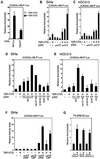Growth suppression of human carcinoma cells by reintroduction of the p300 coactivator
- PMID: 12237408
- PMCID: PMC130588
- DOI: 10.1073/pnas.192586699
Growth suppression of human carcinoma cells by reintroduction of the p300 coactivator
Abstract
The p300 and closely related cAMP response element binding protein (CREB)-binding protein (CBP) acetyltransferases function as global transcriptional coactivators and play important roles in a broad spectrum of biological processes, including cell proliferation and differentiation. A role of p300/CBP in tumor suppression has been proposed from the fact that these coactivators are targeted by viral oncoproteins and that biallelic mutations of p300 have been identified in carcinomas. Here, we show that transcriptional response to the transforming growth factor beta (TGF-beta), an inhibitor of epithelial cell growth, was severely impaired in human carcinoma cell lines carrying p300 mutations accompanied by inactivation of the second allele, and that wild-type expression restored TGF-beta-dependent transcriptional activity. Furthermore, reintroduction of wild-type p300 suppressed the growth of p300-deficient carcinoma cells, whereas p300 did not inhibit the growth of carcinoma cells examined, which have no detectable alterations in p300 protein and retain the TGF-beta-dependent transcriptional response. In addition, tumor-derived mutants missing the bromodomain or glutamine-rich region, which are respectively important for chromatin interaction and coactivator activities, lost the suppressive activity. In contrast, CBP exhibited no or reduced ability to suppress the growth of p300-deficient carcinoma cells. These results provide experimental evidence to show that p300 acts as a suppressor of tumor cell growth and suggest a distinct role of p300 in suppression of epithelial tumors.
Figures





References
-
- Eckner R, Ewen M E, Newsome D, Gerdes M, DeCaprio J A, Lawrence J B, Livingston D M. Genes Dev. 1994;8:869–884. - PubMed
-
- Chrivia J C, Kwok R P, Lamb N, Hagiwara M, Montminy M R, Goodman R H. Nature (London) 1993;365:855–859. - PubMed
-
- Goodman R H, Smolik S. Genes Dev. 2000;14:1553–1577. - PubMed
-
- Ogryzko V V, Schiltz R L, Russanova V, Howard B H, Nakatani Y. Cell. 1996;87:953–959. - PubMed
-
- Bannister A J, Kouzarides T. Nature (London) 1996;384:641–643. - PubMed
Publication types
MeSH terms
Substances
LinkOut - more resources
Full Text Sources
Molecular Biology Databases
Research Materials
Miscellaneous

